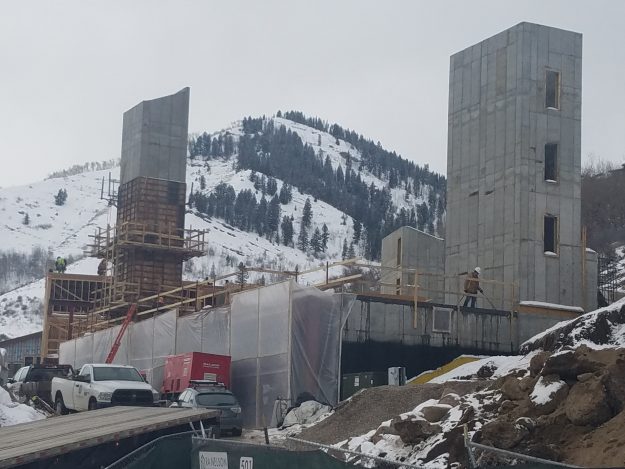Widgetized Section
Go to Admin » Appearance » Widgets » and move Gabfire Widget: Social into that MastheadOverlay zone
Trump may ramp up deportation of construction workers to meet goals

File photo of a job site in Vail several years ago.
As President Donald Trump sends mixed messages about immigration enforcement, ordering new raids on farms and hotels just days after saying he wouldn’t target those industries, he has hardly mentioned the industry that employs the most immigrant laborers: construction.
Nevertheless, the Trump administration is going after construction workers without legal status to meet its mass deportation goals — even as the country has a housing shortage and needs new homes built. A shortage of workers has delayed or prevented construction, causing billions of dollars in economic damage, according to a June report from the Home Builders Institute.
Almost a quarter of all immigrants without a college degree work in construction, a total of 2.2 million workers as of last month, before work site raids began in earnest. That’s more than the next three industries combined: restaurants (1.1 million), janitorial and other cleaning services (526,000) and landscaping (454,000), according to a Stateline analysis of federal Current Population Survey data provided by ipums.org at the University of Minnesota.
Within the construction industry, immigrant workers are now a majority of painters and roofers (both 53%) and comprise more than two-thirds of plasterers and stucco masons. U.S. citizens in construction are more likely to work as managers and as skilled workers, such as carpenters.
Many immigrant workers are likely living here illegally, although there are some working legally as refugees or parolees, and others are asylum-seekers waiting for court dates. There’s also a small number of legal visas for temporary farmworkers, construction workers and others.
The pool of immigrant workers Stateline analyzed were employed noncitizens ages 18-65 without a college degree, screening out temporary workers with high-skill visas.
About half of the immigrant laborers in construction are working in Southern states, including conservative-leaning Florida, North Carolina and Texas, where there is more building going on, according to the Stateline analysis. Another 584,000, or one-quarter, are in Western states, including Arizona, California and Nevada.
In recent months, U.S. Immigration and Customs Enforcement, better known as ICE, has conducted construction worksite raids in Florida in Tallahassee and near Ocala, and in South Texas and New Orleans, as well as more immigrant-friendly California and Pennsylvania.
Roofers may have been the first targeted by new workplace raids because of their visibility, said Sergio Barajas, executive director of the National Hispanic Construction Alliance, a California-based advocacy group with chapters in five other states.
“That’s the first place we heard about it. Roofers are right out there where you can see them,” Barajas said. He added that all segments of construction work have been targeted for ICE raids, and that even some legal workers are not showing up for work out of fear.
“Six or eight weeks ago, I would have said we weren’t affected at all. Now we are. There’s a substantial reduction in the number of workers who are showing up, so crews are 30%, 40% smaller than they used to be,” Barajas said.
In residential construction, a system of contractors and subcontractors opens the door to abuses, said Enrique Lopezlira, director of the Low-Wage Work Program at the University of California, Berkeley. Lopezlira said contractors hire workers, often immigrant laborers, for low-wage jobs and pay them in cash, to save money on benefits and make the lowest possible bid for projects.
“It becomes a blame game. The developers can say, ‘I hired this contractor and I thought he was above board and paying people a decent wage.’ And the contractors can say, ‘I rely on subcontractors,’” said Lopezlira. “It becomes a race to the bottom.”
In many places, residential construction draws more immigrant labor because of looser state and local regulations and lower pay. But in some states with weaker unions and rules that are less strict, such as Texas, the commercial construction industry also employs many immigrants who are here illegally.
Commercial construction costs are 40% lower in Texas than they are in large Northeastern cities where unions are more powerful, said David Kelly, a lecturer in civil and environmental engineering at the University of Michigan.
“The large difference [in cost] suggests workers and their employers in some regions are not paying for income taxes, overtime, Social Security or unemployment insurance,” Kelly said in an email. “Since undocumented workers have limited employment options they may be more willing than others to accept these conditions.”
Despite political claims that Democratic policies result in immigrants taking jobs others need, noncitizen immigrant laborers were about 7% of jobholders nationally as of May — about the same as 2015, according to the Stateline analysis.
That share has hardly budged over the past 10 years, including in 2019 under the first Trump administration, dipping to 6% only in 2020 and 2021.
In construction, however, the share of jobs held by immigrant laborers has increased from 19% in 2015 to 22% in 2024, according to the analysis. Immigrant laborers have gotten more than a third of the 1.5 million jobs added between 2015 and 2024, as home construction reached historic levels.
Editor’s note: This story first ran on Stateline, which is part of States Newsroom, a nonprofit news network supported by grants and a coalition of donors as a 501c(3) public charity. Stateline maintains editorial independence. Contact Editor Scott S. Greenberger for questions: info@stateline.org.


